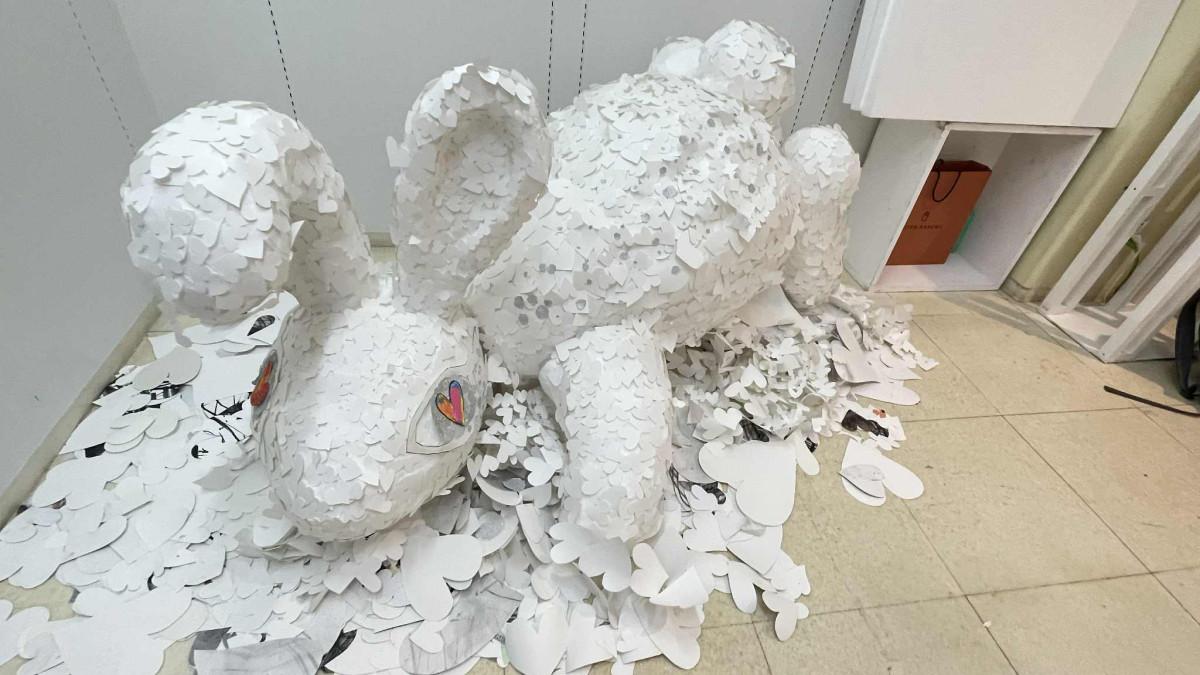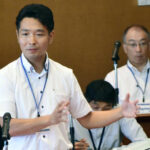A work by Kim Ga-eun from Seoul. While continuing to create pen drawings, she is venturing into three-dimensional art for the first time at EXPLOT since January 2025. The photo shows her current 3D work in progress. The piece depicts ‘The Journey of the Bear and the Rabbit,’ reflecting her belief that ‘daily life can also be seen as a journey.’
At the shared artist-creator space “ExPLOT Studio” (Minatomirai 4, Nishi Ward, Yokohama), an open studio event for the public and several talk sessions will be held starting July 25.
ExPLOT is a coined term combining words like “Experiment,” “PLOT” (concept), and “Lot” (many, place, or studio), based on the word “Exploit,” which signifies achievement and development.
The studio currently hosts 11 long-term residents and seven short-term residents. While usually closed as a private workspace, it fosters interaction between art and diverse fields such as business, IT, welfare, and academia through events and workshops.
The “Open Studio” will take place on July 25 from 5 PM to 8 PM and on July 26 from 1 PM to 8 PM. Additional dates include August 22-23 and September 12-14, with talk events featuring multiple artists scheduled for August 23 and September 12.
On July 25, a talk event titled “ExPLOT TALK: Creation and Life Vol.1” will feature a guest known for designing the Tokyo 2020 Olympics and Paralympics emblems. The guest, active in Yokohama in the early 21st century, began creating patterns with the theme of “connection” starting September 11, 2001, and continues to work across disciplines like art, architecture, and design. Their work includes geometric patterns reproducible with rulers and compasses, as well as three-dimensional designs based on similar principles.
On August 3, a talk titled “Jinen Colloquium #17: To Those Who Dream 100 Years Ahead” will be held, featuring a producer and a childcare facility director whose work revolves around “creating child-rearing for the next century.”
A Yokohama-based participant, who repurposes old kimonos into Western-style clothing as part of an ongoing “Kimono Clothing” project, shared, “The studio provides a calm workspace, and the increasing work requests are a happy challenge. I’ve even worked on outfits for my daughter’s wedding with my mother.”
A programmer, known for a piece titled “The Timer’s Revenge”—where AI counts time for humans and points out discrepancies down to hundredths of a second—explores whether “AI will forgive human mistakes.” They aim to create “two-story” works: “humor on the first floor, philosophy on the second.” They added, “As a programmer, I enjoy exchanging knowledge about art and programming with fellow artists. I feel fortunate to be part of this studio.”
Open Studio events are free with no reservation required. The Jinen Colloquium costs ¥3,000 for the general public, while students can attend for free.
EXPLOT
There is no widely recognized place or cultural site known as “EXPLOT.” It may be a misspelling or a lesser-known location. If you meant a specific site, please provide more details or verify the name for an accurate summary.
ExPLOT Studio
ExPLOT Studio is an innovative design and research collective focused on exploring the intersections of architecture, urbanism, and social engagement. Founded in 2010 by a group of architects and artists, the studio emphasizes experimental projects that challenge conventional spatial practices. Their work often involves community participation, adaptive reuse of urban spaces, and interdisciplinary collaborations.
Minatomirai 4
Minatomirai 4 is a modern commercial and cultural district in Yokohama, Japan, known for its sleek skyscrapers, shopping centers, and entertainment venues. Developed as part of the larger Minato Mirai 21 urban renewal project in the 1980s, it transformed former dockyards into a vibrant waterfront area. Today, it is a symbol of Yokohama’s innovation, featuring landmarks like the Landmark Tower and Cosmo Clock 21 Ferris wheel.
Nishi Ward
Nishi Ward is a district located in Yokohama, Japan, known for its mix of residential areas, commercial hubs, and cultural sites. Historically, it developed as part of Yokohama’s expansion in the late 19th and early 20th centuries, with landmarks like the Mitsubishi Heavy Industries shipyard reflecting its industrial heritage. Today, it offers attractions such as parks, shopping centers, and proximity to Yokohama’s waterfront.
Yokohama
Yokohama is a major port city in Japan, located south of Tokyo, known for its vibrant cultural mix and historical significance as one of the first Japanese ports opened to foreign trade in 1859. The city boasts landmarks like the Yokohama Chinatown, one of the largest in the world, and the iconic Red Brick Warehouse, a symbol of its Meiji-era modernization. Today, Yokohama blends its rich history with modernity, offering attractions such as the futuristic Minato Mirai district and the scenic Yamashita Park.
Tokyo 2020 Olympics and Paralympics emblems
The emblems for the Tokyo 2020 Olympics and Paralympics, designed by artist Asao Tokolo, feature a harmonized checkered pattern (*ichimatsu moyo*) in indigo blue, symbolizing unity and diversity. Inspired by traditional Japanese *ichimatsu* designs and the concept of “Unity in Diversity,” the emblems were selected in 2016 but faced controversy over plagiarism allegations, which were later dismissed. The Games, delayed to 2021 due to the COVID-19 pandemic, showcased these emblems as a representation of Japan’s cultural heritage and global inclusivity.
Jinen Colloquium
The **Jinen Colloquium** is an academic and cultural forum that fosters dialogue on philosophy, spirituality, and interdisciplinary studies, often exploring themes related to Japanese and global thought. While its exact founding history is not widely documented, it serves as a platform for scholars and thinkers to exchange ideas, drawing from both traditional wisdom and contemporary perspectives. The colloquium emphasizes reflective discourse, bridging Eastern and Western intellectual traditions.
Kimono Clothing
Kimono clothing is a traditional Japanese garment known for its elegant, long robes with wide sleeves, tied with an obi (sash). Historically worn daily in Japan, kimonos became formal attire after Western-style clothing gained popularity in the Meiji era (late 19th century). Today, they are worn for special occasions like weddings, tea ceremonies, and festivals, symbolizing Japanese cultural heritage.





